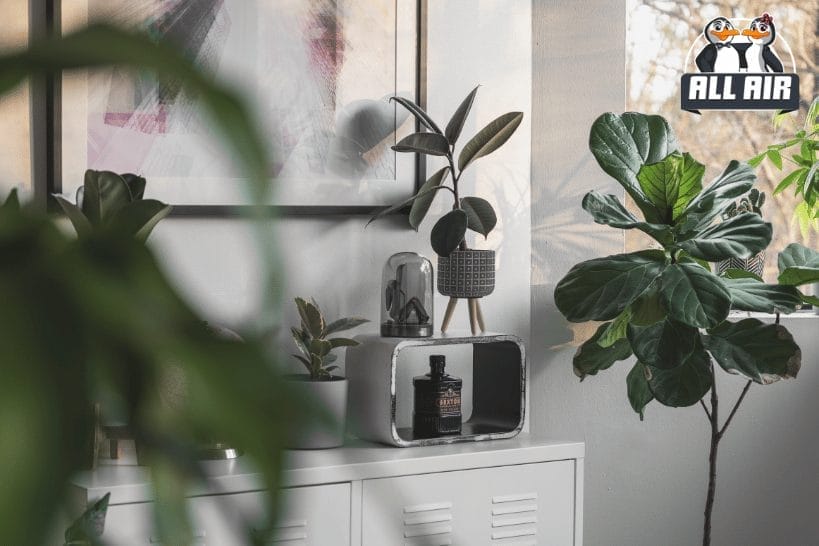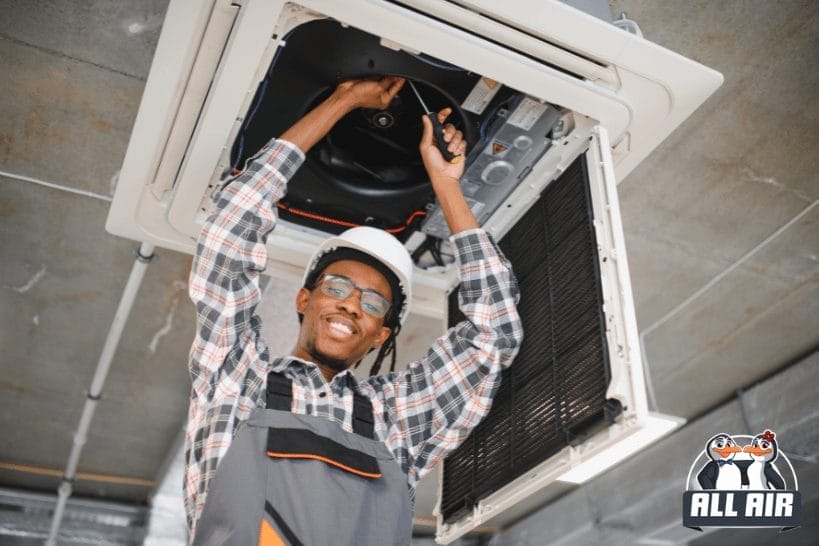Indoor air quality is often worse than outdoor air, even in urban areas. Most people spend 90% of their time indoors, where common pollutants build up over time. These include mold spores, pet dander, dust mites, and fumes from everyday activities like cooking or cleaning. You can improve the quality of your home’s air by focusing on the right habits, tools, and systems.
This guide outlines the most effective ways to improve indoor air quality using proven, practical methods. Each step is easy to implement and helps reduce risk from avoidable household pollutants.

What Causes Poor Indoor Air Quality?
Indoor air becomes polluted when small particles or gases accumulate inside. Most of these come from sources inside your home. Others enter from outside and stay trapped.
Common indoor sources include:
- Cooking fumes, especially from gas burners
- Building materials, carpets, and new furniture that release chemicals over time
- Mold spores from damp areas
- Tobacco smoke or residue
- Cleaning products and air fresheners with strong scents or solvents
- Pet dander and dust mites on carpets, furniture, and curtains
Outdoor air pollution also matters. Nitrogen dioxide and particulate matter can enter your home through open windows, intake vents, or even small gaps in older buildings.
Even low levels of pollution can affect people over time, especially children, older adults, or those with asthma or other respiratory issues.
Signs the Air in Your Home Is Unhealthy
Poor indoor air quality doesn’t always have clear warning signs. But over time, certain signs or symptoms suggest a problem.
- Frequent coughing, sneezing, or sinus congestion indoors
- Persistent headaches or eye irritation at home
- Visible mold growth in damp areas like bathrooms or basements
- A stale or chemical smell that doesn’t go away with cleaning
- Excessive dust buildup near vents or along furniture
These signs are common in poorly ventilated homes or those with aging HVAC systems. If ignored, they may lead to more serious health issues.
Reduce Pollution at the Source
The best way to improve air quality is to reduce the amount of pollution entering your home to begin with. This is called source control.
Cooking and Kitchen Areas
Cooking, especially over gas stoves, releases fine particles and nitrogen dioxide into the air. Always run your kitchen vent hood while cooking, and if possible, crack a window.
Tobacco Smoke
Smoke from cigarettes or cigars releases particles and gases that stay in fabrics, walls, and the HVAC system. Do not allow smoking indoors.
Pets
Brush and bathe pets regularly. Keep them off furniture if possible, and wash their bedding often. Use vacuums with HEPA filters to remove pet dander.
Cleaning and Air Fresheners
Avoid strong chemical cleaners and sprays. Many contain volatile organic compounds (VOCs). Instead, choose unscented or low-VOC products and avoid using multiple air fresheners in closed areas.

Improve Air Flow and Ventilation
Stale air needs to be replaced by fresh air to maintain good indoor air quality. This is especially important in modern buildings designed to be energy efficient, which often trap pollutants inside.
Open windows when outdoor air quality is acceptable. A cross breeze can quickly remove indoor pollutants. Use fans to keep air moving and prevent stagnant areas.
Heating and cooling systems also play a role. Many HVAC systems allow you to set fresh air intake levels. If your system doesn’t include this feature, portable air purifiers with HEPA filters can help clean single rooms.
Use Good Air Filtration
Proper filters remove dust, pollen, pet dander, and other small particles from the air before you breathe them in. There are several key ways to do this at home.
HVAC System Filters
Your central air system is the main line of defense. Replace air filters every 1–3 months, depending on usage and occupancy. Choose filters rated MERV 8 to MERV 13 for most homes. These offer a good balance between filtration and airflow.
Portable HEPA Filters
A portable air purifier with a HEPA filter can remove 99.97% of airborne particles down to 0.3 microns. These are useful in bedrooms, nurseries, or other closed spaces where you spend a lot of time.
Vacuum With a Filter
Vacuuming without the right kind of filter spreads dust instead of removing it. Use a vacuum cleaner with a built-in HEPA filter to remove small allergens and particulate matter effectively.
Maintain Ideal Humidity Levels
Humidity affects both comfort and air safety. When humidity is too high, mold grows more easily. When it’s too low, dry air causes skin irritation and worsens sinus problems.
The ideal indoor humidity level is between 30% and 50%. Simple humidity monitors (hygrometers) can help you track levels. If your home is too damp—like a basement or laundry room—run a dehumidifier. If the air is too dry, especially in cold climates, use a humidifier.
Your HVAC system also affects humidity. Make sure your cooling system drains moisture properly. If it doesn’t, mold spores can grow inside your air ducts.

Routine Cleaning Makes a Difference
Routine cleaning reduces many of the particles that lower your air quality. Focus on areas with high dust buildup and fabrics that collect allergens.
- Vacuum carpets, rugs, and upholstery at least once a week
- Dust surfaces with microfiber cloths that trap particles
- Wash bedding weekly in hot water to kill dust mites
- Clean or replace curtains and pet bedding often
Avoid harsh aerosol sprays or heavily scented products. Use natural cleaners when possible and ventilate the space when cleaning.
Pay Attention During Renovations or Repairs
New flooring, paint, or insulation can release gases for days or even weeks. Always ventilate during and after renovation work. If possible, seal off the area from the rest of your home and allow materials time to off-gas before use.
Check that your HVAC system stays clean during construction. Close off vents and replace filters after any dust-heavy work.
When Outdoor Air Affects the Inside
Outdoor air quality changes daily. On days with smoke, high ozone, or industrial pollution, keep windows closed. Use air purifiers and your HVAC system’s fan to keep air moving and filtered.
Pay attention to local air quality indexes (AQI), especially in summer or wildfire season. Even brief exposure to outdoor contaminants inside your home can lower indoor air quality.
Do Houseplants Actually Help?
Some indoor plants can improve air quality by absorbing certain airborne pollutants through their leaves and roots. They also help maintain indoor humidity by releasing moisture into the air. Plants like spider plants, peace lilies, and snake plants have shown the ability to remove small amounts of volatile organic compounds (VOCs) from indoor spaces.
These effects are real, but they’re limited. Meaningful improvement in indoor air quality would require a high number of plants per room—far more than most people are willing or able to maintain. And while plants do absorb carbon dioxide and release oxygen during the day, they don’t filter out particulate matter, mold spores, or allergens.
Still, houseplants have their place:
- They offer small-scale air benefits when chosen and placed thoughtfully.
- They can support humidity balance in dry indoor environments.
- They encourage daily habits of care and observation, which often lead to broader attention to home air quality.
To get the most out of your plants, avoid overwatering and keep the soil from staying wet for long periods. Mold can grow in damp pots and undo the air quality gains you’re trying to achieve.
Healthy houseplants can be part of a cleaner indoor environment—but they work best when combined with proper ventilation, filtration, and moisture control.

Monitor Air Quality in Your Home
You can’t manage what you don’t measure. Indoor air quality monitors can track particulate matter, temperature, humidity, and VOCs. These tools provide feedback that helps you adjust ventilation, cleaning routines, and filtration levels.
If you regularly see high readings—or symptoms persist—it may help to consult an HVAC technician to assess your system for leaks, poor filtration, or microbial growth.
Clean Air Starts at Home
Improving indoor air quality doesn’t require a full system overhaul. Focus on small steps: limit sources of pollution, ventilate your space when you can, and maintain your HVAC and filtration systems. Keep humidity balanced and stay alert to outdoor conditions.
Breathe easier—starting with where you live.

